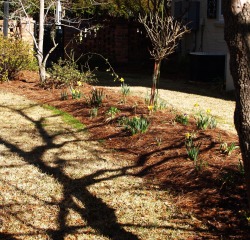Soil Testing and Soil pH Creating Microclimates Selecting Healthy Plants Growing Peonies In The SouthGo Organic At Home
Pruning Shrubs Making a Wildlife Habitat in Your Backyard Wide Row Planting
Pruning Shrubs Making a Wildlife Habitat in Your Backyard Wide Row Planting
Creating Microclimates Cont.
Once you have established the shade, be it natural or unnatural, you have
created a slightly less harsh miniature environment. You must remember this is a gradual process; look at what exists for plantings or shade provider in the area and then finding a new plant to put in the shade of the existing item. Now your choices are a little more open. You don't have to go with a plant rugged enough to take the sun like you did before, you can now even choose to add a plant that survives in cooler weather.
Climate Conditions: If you want to grow plants that don't like getting their feet wet or have a hard time handling the humidity in the south like Lavender, it may make sense that amending the flower bed itself with sand would improve your drainage and solve your problems. However, the exact opposite is the result of doing this. You end up with is a flower bed into which water will flow easily.
created a slightly less harsh miniature environment. You must remember this is a gradual process; look at what exists for plantings or shade provider in the area and then finding a new plant to put in the shade of the existing item. Now your choices are a little more open. You don't have to go with a plant rugged enough to take the sun like you did before, you can now even choose to add a plant that survives in cooler weather.
Climate Conditions: If you want to grow plants that don't like getting their feet wet or have a hard time handling the humidity in the south like Lavender, it may make sense that amending the flower bed itself with sand would improve your drainage and solve your problems. However, the exact opposite is the result of doing this. You end up with is a flower bed into which water will flow easily.

Berm
Creating a berm or a raised bed will accomplish what you need - a flower bed that will drain excess water rapidly. If you want to grow plants that like staying wet and have sandy soil in your yard, you can make a rain garden. This can be done simply by digging the soil out of the bed to a depth of about 18". Amend the soil with plenty of organic matter that is known to retain moisture, for example you can use shredded peat moss. You will need a pond liner which you can purchase in either packaged, predetermined dimensions or have it cut-to-measure at your nearby home improvement store or specialty pond shop. If it is a small area which will not hold a lot of plantings and will not be disturbed with additional planting, you can use heavy plastic yard waste bags in lieu of a pond liner. Once you have laid your liner of choice in the dug out area, covering the base and sides, overlapping it as necessary and leaving a collar on the outside of the top area, punch holes through the liner to allow for drainage and then fill the bed with the amended soil. Make sure the bed actually forms a depression or low area in the yard so that water from the surrounding area will flow into it. You now have an area that will retain moisture and you can even grow plants such as Iris where you couldn't before.
Although winters in the south can be mild, an unusual cold snap that might only happen once every 3 or 4 years can undo years of work. If you want to grow plants that normally grow farther south, try planting them on the south side of a house or other heated building. These buildings, which can radiate heat throughout the night, will help them survive most cold snaps.
Finally:Since everyone's goals and gardening setups are slightly different, I can't explain every stage of the process for creating microclimates in your yard to meet your vision. But to reach your goal, you should do research on every plant that you would like to have in your garden. Find out everything you can about the zone that it flourishes in, and ask yourself how you can emulate that zone within your own backyard. Almost always you can take control of the environment and recreate whatever you wish. Usually all it takes is planning, strategy and time.
Page 1 2
Although winters in the south can be mild, an unusual cold snap that might only happen once every 3 or 4 years can undo years of work. If you want to grow plants that normally grow farther south, try planting them on the south side of a house or other heated building. These buildings, which can radiate heat throughout the night, will help them survive most cold snaps.
Finally:Since everyone's goals and gardening setups are slightly different, I can't explain every stage of the process for creating microclimates in your yard to meet your vision. But to reach your goal, you should do research on every plant that you would like to have in your garden. Find out everything you can about the zone that it flourishes in, and ask yourself how you can emulate that zone within your own backyard. Almost always you can take control of the environment and recreate whatever you wish. Usually all it takes is planning, strategy and time.
Page 1 2
